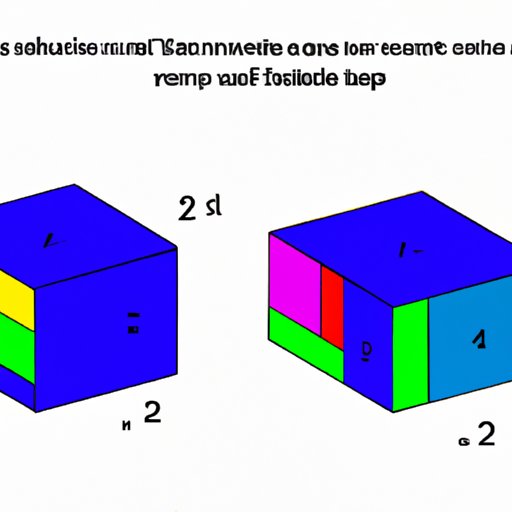
Introduction
Understanding the surface area of a cube is essential in various fields such as architecture, gaming, and engineering. Knowing how to calculate a cube’s surface area enables you to determine the amount of material required for construction, create 3D models in games, and design prototypes in the engineering field. This article provides a comprehensive guide on how to find the surface area of a cube, practical applications of this knowledge, and common mistakes to steer clear of when solving surface area problems.
Listicle: “5 Simple Steps to Find the Cube’s Surface Area”
The following five steps make it easy to find the surface area of a cube:
- Determine the length of one side of the cube
- Use the formula A = 6s^2 to find the surface area of the cube
- Multiply the length of one side by itself (s * s)
- Multiply the result from step three by six (6 * s * s)
- Units of measurement should be squared since surface area represents the total area of all faces of a cube.
Let’s use an example of a cube with a length of 5cm to illustrate these steps. First, determine the length of one side of the cube, which in this case is 5cm. Next, plug the value into the formula: A = 6s^2. Use the length of one side (5cm), square it (5cm * 5cm = 25cm^2), then multiply by 6 (25cm^2 * 6 = 150cm^2).
Visual Guide: “Graphic Tutorial on How to Find the Surface Area of a Cube”
The following graphic tutorial provides a visual representation of the five steps in finding the surface area of a cube:

The graphic illustrates that the formula for calculating surface area is to multiply the length of one side (s) by itself, then multiply that result by six. Surface area is in units squared since it represents total area.
Practical Approach: “Real-life Examples of How Surface Area of a Cube is Used in Daily Life”
Knowing the surface area of a cube has practical applications in daily life. Some situations where knowledge of cube surface area is beneficial include:
- Construction: Surface area is used to determine the amount of materials, such as wood or bricks, needed to build a cube-shaped structure.
- Design: Architects and designers use surface area to create 3D models of buildings and objects in various fields, such as advertising.
- Mathematics: Surface area is an essential concept in geometry that helps to understand three-dimensional shapes.
The application of surface area knowledge extends to everyday activities such as gardening, cooking, and interior decor. For instance, if you need to fertilize your garden bed, knowing the surface area of the soil in the bed can help you determine the amount of fertilizer to apply for optimal growth.
Storytelling: “The Journey of a Cube: Discovering Its Surface Area”
The journey of a cube can help one understand the significance of knowing surface area. In this hypothetical scenario, let’s imagine that a cube-shaped pet house is being designed. The pet owner wants to ensure that the house is designed with enough space to accommodate their pet comfortably. The designer measures the cube and determines the surface area using the steps outlined in this article. The result helps the designer determine the amount of material needed, the size and shape of the walls, and the framework required to create a stable pet house. Understanding surface area ensures that the pet house is designed to meet the owner’s requirements and accommodate their pet’s needs, promoting comfort and safety.
Common Mistakes to Avoid: “Top Six Mistakes to Steer Clear of When Finding the Surface Area of a Cube”
When finding the surface area of a cube, it is crucial to avoid the following common mistakes:
- Using the wrong formula to calculate surface area
- Mistaking area for the perimeter
- Incorrectly measuring one side of the cube
- Forgetting to square the length of one side
- Multiplying by the wrong factor
- Incorrectly converting units of measurement
One must be careful to avoid these common mistakes, which can lead to incorrect results and flawed structures.
Conclusion
Understanding how to find the surface area of a cube is essential in various fields and everyday life situations. By following the five simple steps outlined in this article, one can calculate the surface area of a cube accurately. Additionally, knowing surface area’s practical applications and common mistakes to avoid when finding it ensures that constructions are safe, and other applications are optimized. With this knowledge, one can design and create with precision and confidence.





